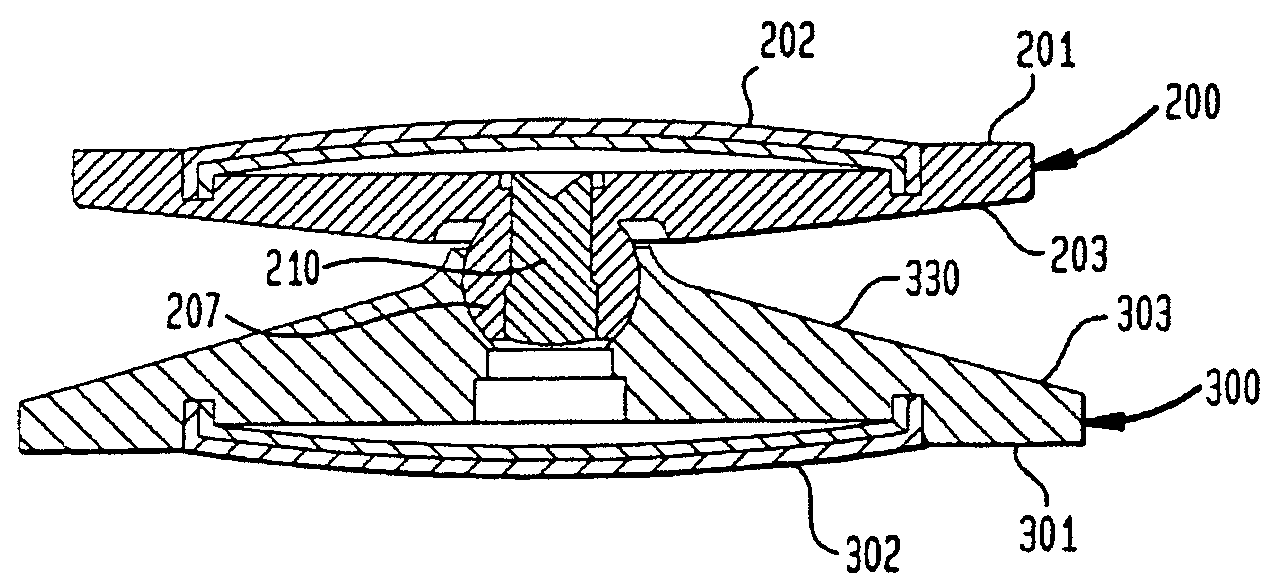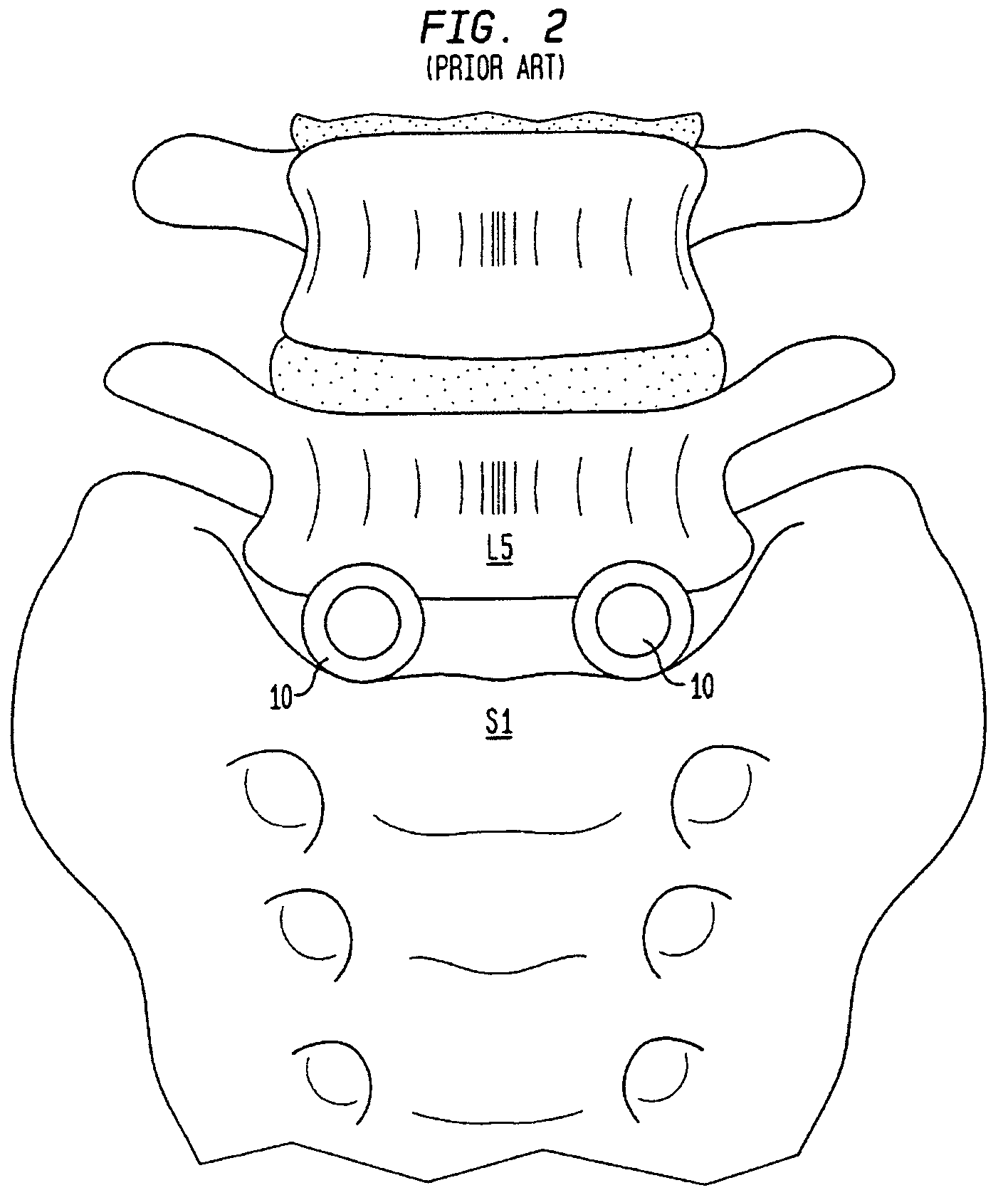[0020]To enhance the securing of the plate members to the vertebral bones, each plate member further comprises at least a lateral ring of porous coating (which may be a sprayed deposition layer, or an adhesive applied beaded metal layer, or other suitable porous coatings known in the art). This porous ring permits the long-term ingrowth of vertebral bone into the plate member, thus permanently securing the prosthesis within the intervertebral space. It shall be understood that this porous layer may extend beneath the domed metal mesh as well, but is more importantly applied to the lateral rim of the exterior surface of the plate member that seats directly against the vertebral body.
[0021]The spring mechanism disposed between the plate members provides a strong restoring force when a compressive load is applied to the plates, and also permits rotation and angulation of the two plates relative to one another. While a wide variety of embodiments are contemplated, a preferred embodiment of the spring mechanism includes a belleville washer utilized as the restoring force providing element, the belleville washer being spirally slotted and having radially extending grooves. In general, the belleville washer is one of the strongest configurations for a spring, and is highly suitable for use as a restoring force providing subassembly for use in an intervertebral spacer element which must endure considerable cyclical loading in an active human adult.
[0024]To dispose the spring mechanism between the plate members, the plate members of the artificial intervertebral disc comprise features suitable for this purpose. The spirally slotted and radially grooved belleville washer is utilized in conjunction with a ball-shaped protuberance on which it is free to rotate through a range of angles (thus permitting the plate members to rotate relative to one another through a corresponding range of angles). More particularly, one of the plate members has a circular recess on its interior surface, for housing the wide end of the belleville washer and allowing it to expand in unrestricted fashion when the belleville washer is compressed. The other of the plates has the ball-shaped protuberance on its interior surface, for rotatably holding the narrow end of the belleville washer. The protuberance has a central axial bore that receives a rivet (or a set screw, if the bore is threaded). Prior to the insertion of the rivet, the ball-shaped protuberance can deflect radially inward (so that the ball-shaped protuberance contracts). The insertion of the rivet eliminates the capacity for this deflection. The belleville washer is mounted to this ball-shaped knob in such a way that it may rotate freely through a range of angles equivalent to the fraction of normal human spine rotation (to mimic normal disc rotation). The belleville washer includes an enlarged inner circumferential portion (at the center of the washer) which accommodates the ball-shaped protuberance. The enlarged portion includes a curvate volume having a substantially constant radius of curvature which is also substantially equivalent to the radius of the ball-shaped protuberance. The deflectability of the ball-shaped protuberance, prior to the insertion of the rivet, permits the protuberance to be inserted into the interior volume at the center of the belleville washer. Subsequent introduction of the rivet into the axial bore of the protuberance prevents the protuberance from deflecting. Thereby, the washer can be secured to the ball-shaped protuberance so that it can rotate thereon through a range of angles.
[0025]This assembly provides spring-like performance with respect to axial compressive loads, as well as long cycle life to mimic the axial biomechanical performance of the normal human intervertebral disc. The spiral slots and radially extending grooves of the belleville washer allow the washer to expand radially as the slots and grooves widen under the load, only to spring back into its undeflected shape upon the unloading of the spring. As the washer compresses and decompresses, the walls of the circular recess maintain the wide end of the washer within a prescribed boundary on the internal face of the base plate which it contacts. The assembly further withstands tension loads on the vertebral body contact surfaces, because the rivet in the axial bore prevents the protuberance from deflecting, thus preventing the protuberance from exiting the curvate volume at the center of the belleville washer when the artificial intervertebral disc is under a tension load. Accordingly, once the plate members are secured to the vertebral bones, the assembly will not come apart when a normally experienced tension load is applied to the spine, similar to the tension-bearing integrity of a health natural intervertebral disc. The assembly further provides a centroid of motion centrally located within the intervertebral space, because the plate members are made angulatable relative to one another by the ball-shaped protuberance being rotatably coupled in the curvate volume of the enlarged portion of the belleville washer. The centroid of motion remains in the protuberance, and this remains centrally located between the vertebral bodies, similar to the centroid of motion in a healthy natural intervertebral disc.
 Login to View More
Login to View More  Login to View More
Login to View More 


